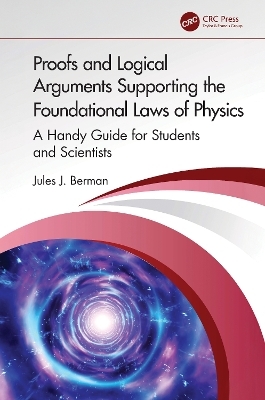
Proofs and Logical Arguments Supporting the Foundational Laws of Physics
CRC Press (Verlag)
978-1-032-85067-2 (ISBN)
- Noch nicht erschienen (ca. April 2025)
- Versandkostenfrei innerhalb Deutschlands
- Auch auf Rechnung
- Verfügbarkeit in der Filiale vor Ort prüfen
- Artikel merken
For scientists, students, and curious laypersons, this compilation, Proofs and Logical Arguments Supporting the Foundational Laws of Physics: A Handy Guide for Students and Scientists examines the most important laws and relationships taught in science courses, attaching a short and accessible proof or logical argument for each assertion.
Every thoughtful person should seek to understand why we think we know what we say we know about the natural world. Otherwise, we may as well surrender ourselves to a world ruled by magic. In 136 essays, readers are provided with proofs and logical arguments supporting the laws and relationships that serve as the foundation of our rational understanding of reality. Among the essays included in this book, we will find proofs of Pauli’s exclusion principle, Heisenberg’s uncertainty principle, the principles of special relativity, the Schrodinger wave equation, Noether’s theorem, and many of the laws of physics and chemistry that no scientist should accept on blind faith alone.
Laypersons will find that the ideas discussed in this volume are always thought-provoking and sometimes inspiring. For university undergraduates, the book will serve as an introduction to the core sciences. Graduate students may find this book to be a handy cross-disciplinary reference that explains how the tools of their own selected discipline have emerged from fundamental principles that unify all the sciences.
Jules J. Berman received two baccalaureate degrees from MIT (from the Department of Mathematics, and from the Department of Earth and Planetary Sciences). He holds a PhD from Temple University, and an MD, from the University of Miami. His postdoctoral studies were completed at the US National Institutes of Health, and his residency was completed at the George Washington University Medical Center in Washington, DC. Dr. Berman served as Chief of Anatomic Pathology, Surgical Pathology, and Cytopathology at the Veterans administration Medical Center in Baltimore, Maryland, where he also held joint appointments at the University of Maryland Medical Center and at the Johns Hopkins Medical Institutions. In 1998, he transferred back to the US National Institutes of Health, as a Medical Officer, and as the Program Director for Pathology Informatics in the Cancer Diagnosis Program at the National Cancer Institute. Dr. Berman is a past president of the Association for Pathology Informatics, and is the 2011 recipient of the Association’s Lifetime Achievement Award. He has first-authored more than 100 journal articles and has written more than 20 single-author science books.
Jules J. Berman received two baccalaureate degrees from MIT (from the Department of Mathematics, and from the Department of Earth and Planetary Sciences). He holds a PhD from Temple University, and an MD, from the University of Miami. His postdoctoral studies were completed at the US National Institutes of Health, and his residency was completed at the George Washington University Medical Center in Washington, DC. Dr. Berman served as Chief of Anatomic Pathology, Surgical Pathology, and Cytopathology at the Veterans administration Medical Center in Baltimore, Maryland, where he also held joint appointments at the University of Maryland Medical Center and at the Johns Hopkins Medical Institutions. In 1998, he transferred back to the US National Institutes of Health, as a Medical Officer, and as the Program Director for Pathology Informatics in the Cancer Diagnosis Program at the National Cancer Institute. Dr. Berman is a past president of the Association for Pathology Informatics, and is the 2011 recipient of the Association’s Lifetime Achievement Award. He has first-authored more than 100 journal articles and has written more than 20 single-author science books.
Preface.
1. Particles and Atoms
2. Waves and Forces
3. Universe and Cosmos
4. Existences
5. Handy Math
6. Index
| Erscheint lt. Verlag | 21.4.2025 |
|---|---|
| Zusatzinfo | 29 Line drawings, black and white; 9 Halftones, black and white; 38 Illustrations, black and white |
| Verlagsort | London |
| Sprache | englisch |
| Maße | 156 x 234 mm |
| Themenwelt | Mathematik / Informatik ► Mathematik ► Angewandte Mathematik |
| Naturwissenschaften ► Biologie | |
| Naturwissenschaften ► Chemie ► Physikalische Chemie | |
| Naturwissenschaften ► Physik / Astronomie | |
| ISBN-10 | 1-032-85067-1 / 1032850671 |
| ISBN-13 | 978-1-032-85067-2 / 9781032850672 |
| Zustand | Neuware |
| Haben Sie eine Frage zum Produkt? |
aus dem Bereich


